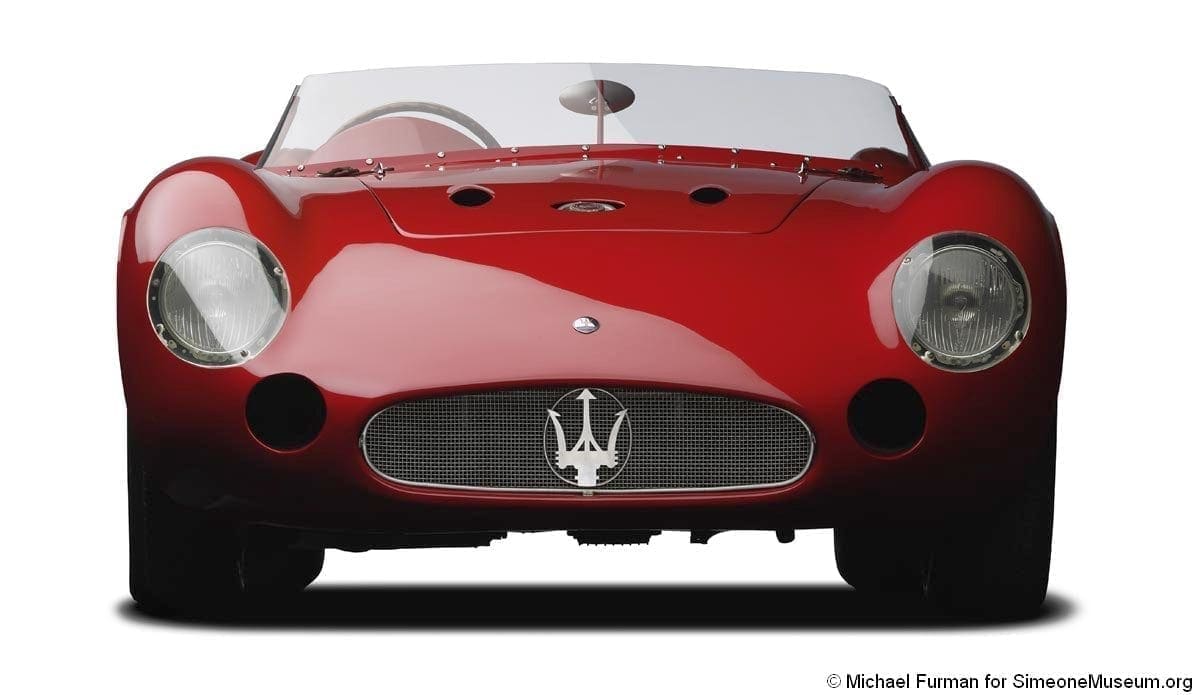Our car raced at Le Mans twice in 1956-1957. They later fitted it with a Corvette V8 before being we reunited it with its original engine after many years.
THESE CARS
Between 1955 and 1959, they built twenty-six 300S Maserati cars with three versions of increasing sophistication. By then, Maserati had a car competitive with the best sports racing cars of its class and for many drivers, such as Stirling Moss, they considered it a favorite. Straight-six racing engines were popular with Maserati from the early 1950s.
There was a success in the two-liter class with the A6GCS double overhead cam engines and the 300S engine was developed after successes with the identically engine-equipped 250F Grand Prix racing car. By increasing the stroke, the Maserati company now had a 240 horsepower engine (at 7200 RPM). Maserati then experimented with engines increasing from 2.8 liters to a final version, a 3-liter powerhouse capable of 260 horsepower at 6500 RPM.
The motor had double overhead cams and detachable cylinder head. Each camshaft had seven bearings, and each valve had three coil springs. Ultimately, the engines carried three 45DCO3 Weber carburetors. A stiff seven-disc clutch engaged the transaxle. A four-speared transaxle driving a deDion rear was mounted on six Silentbloc bushings. The front suspension had a coil spring and wishbone configuration, connected to the bottom suspension arms. Beautiful drum brakes appeared on the first 300S cars, but later on, such as on our car (3077), they used larger 450S drums, making this an unbeatable drum brake combination.
There were three types of body versions. There were eleven short-nosed cars, four interim cars, and eighteen long-nosed cars, of which seven were converted by the factory from previous models (including ours, 3056 to 3077).
The race history of these remarkable cars was spotty, but superior to any post-War Maserati sports car racing in the big leagues. The 1955 World Championship Series ended with Mercedes Benz the winner with 23 points and Maserati fourth with 15 points. For 1956, the fortunes were better. Entering the Nurburgring 1,000 Kilometer Race, Ferrari was the leading world championship sports car.. After an exciting battle, Moss in a 300S overtook Fangio’s Ferrari to win. Subsequent bad luck followed the team, however, and the 1956 Championship ended with 36 points for Ferrari and Maserati, in second place, with 18 points.
For 1957, the Maserati team now included the 450S with a 4.5 liter V-8, four camshafts, 400 horsepower engine (by far the fastest racing sports car of the 1950s). Moss finished second in the Buenos Aires race in January. By the end of the Sebring Race, Maserati, with
At the 1957 Le Mans, the 450S was scheduled to be the star of the Maserati show. Both the 450Ss and the lone 300S, our car that was
OUR CAR
This car, initially numbered 3056, has a build date of June 1955. Apparently the first race was the Portuguese Grand Prix on June 26, 1955, but, only six days old, it did not appear. One month later it finished second in the Portugal Grand Prix and then it competed in some small races. The car finished eighth overall in the May 1956 Silverstone Race and they entered it at the 1,000 KM Nurburgring Race on May 27th, but it did not appear.
It did not finish the June 30th 12-hour race at Rheims, and then apparently went back to the factory for an upgrade. A new long-nosed body was fitted, brakes from the 450S were upgraded on all four wheels, and they installed a new engine with a stronger crankshaft. On June 22, 1957, it appeared in the 24 hours of Le Mans as Race #12. It was numbered 3056 for this race, but had to retire because of clutch problems.
Maserati historian Walter Baumer concludes that this car took part in the Grand prix at Kristianstad, near Stockholm. It raced successfully there and returned to Italy when sport activity in the factory ceased because of financial difficulties. They passed the car on to Scuderia Centro Sud, for whom Jean Behra raced.
During this time, the car received a new engine, number 3077 and given that chassis number on January 14, 1958. Centro Sud owed Jean Behra for his racing activities and in the absence of six million lira, they apparently gave the car to Behra. He came in second place in Oporto, Portugal. In need of funds, Behra sold the car to dealer Gerino Gerini, after the factory refreshed the car. (Although it may still have been owned by Centro Sud based on stickers still with the car).
It came in tenth in the Sussex Trophy Race at Goodwood, driven by Brazilian Hermano da Silva Ramos. Soon after, Gerini sold the car to American Paul Growley, who sold it in late 1959 to Bill Dixon. Dixon replaced the engine with a Chevrolet V-8 unit and was driven by Dixon for several races until sold to Dan Smith in the mid-1970s.
At one time, it was owned by automobile dealer Len Renick. He later advertised it for sale and via Keith Duly, we purchased the car with a 3500 GT engine, but otherwise it was very complete. I sent it over to Neil Twyman’s shop, where it Maserati expert Steve Hart looked it over. He said the body had its original panels, fuel and oil tanks, steering wheel, front and rear bonnets, all wheels original, and the chassis had all factory specifications. Front suspension and rear axle were intact, and also the transaxle. Dashboard and windshield posts were all in place. In fact, the car was complete except for the engine.
We could get engine number 3073, which reluctantly I planned to install in the car. I say reluctantly because virtually all of our cars have their original numbered engines. The 3073 went to Cyril Embrey for a complete rebuild, and, as luck would have it, just as the engine was being completed, collector Bob Rubin called me to let me know that he had purchased a 250F replica Maserati with engine number 3077…the engine from my car. I immediately swapped the engine for some significant Maserati A6GCS parts and cash, and sent it directly to Cyril, who did a perfect rebuild. The completion of his rebuild coordinated nicely with Neil’s work, and they installed 3077 engine, making it a complete car as it last left the factory. The rebuild required essentially no non-original bits, and mainly repairs to the front end.
Before we painted the car, I was informed that the Silverstone Race was coming up, and they approached me to race the car, though it still was not painted, as its initial re-entry into the competition world. The driver was to be Willie Green, known both for his skill and his love of cars. He also had restoration experience. I cleared this with Cyril Embrey, and he assured me that Willie would take great care of the car.
Soon after, I saw it rounding the track in four-wheel drifts, with Willie driving it as if he had owned it for decades. His confidence was awe-inspiring since I had no insurance or other way to protect either Willie, myself, or the car. I understand, that day he set a lap record for cars of that vintage!
After I painted her, the British Motoring Press tested her and then she returned here for a much more sedate life. While driving it at the Bridgehampton track I had a problem with overheating of the transaxle which David George discovered was because of a tight lashing and he quickly cured this. She remains a delight to drive, a beauty to look at, and a high-water-mark of a company whose level of engineering expertise and styling talent was not matched by its financial backing.

If you wanna run cool, you got to run / On heavy, heavy fuel.
Mark Knopfler












